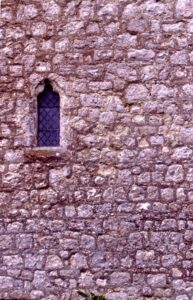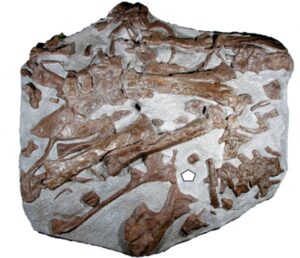Last night I watched ‘Flog It’ as usual. For a few minutes, the program was from Maidstone Museum where the fossil Iguanodon was featured. About 120 million years ago the area around what is now Kent was under the sea. Slow climate change, possibly brought about by the earth’s wobble, precession, as it circles the sun, resulted in alternate layers of what was called, by quarrymen, ragstone and a softer material they called hassock. Most ragstone layers are a convenient 50 cm thick. That all this rock was laid down in the sea is shown by the marine fossils, such as ammonites, found in the rock.
Ragstone is hard, and is an ideal building material, especially in an area of the country without any other suitable building stone. Unfortunately, it is ragged as the name implies, and seldom presents a smooth surface. It is also very hard. In the days before steel, chisels soon became blunt and so ‘dressed’ stone was very expensive. Many local walls in Maidstone show this haphazard arrangement of stone, but expensive buildings, such as the Tower of London and Maidstone Prison, show much more regular worked material.

~ Ragstone Church wall~
Gideon Mantell was a doctor, living in Lewes, in the early 19th century. He was very interested in fossils but had no University education and so was reluctantly accepted as a hanger on by the Geological elite. He, or his wife, found a strange tooth in Sussex but even Baron Cuvier, the eminent French palaeontologist could not decide what it was, suggesting, at first, that it could be a broken piece of a fossil rhinoceroses’ tooth. There the problem lay, unresolved. Much later, Mantell went to the Natural History Museum to see another worker who, quite by chance, had a stuffed iguana lizard on his desk. Interested, he took a closer look and realised that the teeth were a miniature version of the one he had found earlier. So it was after a modern iguana that the fossil one was named Iguanodon, (don means tooth) which, scaled up ten times (Mantell’s tooth was about ten times the size of an iguana’s) made the fossil about sixty feet long.

~ Iguanodon teeth being excavated ~
Some 12 years later, William Bensted had a problem in his quarry in Queens Road Maidstone. An unusually large piece of ragstone had been unearthed and was now it the way. His workmen drilled a hole, using a long chisel and brute force with a sledgehammer into the centre, filled it with gunpowder, lit the blue touchpaper, and ran. Exposed were a mass of enormous bones. Bensted was already interested in the fossils his men found and spent some time collecting the scattered pieces and removing some of the overlying rock. He made a drawing of what he had found and later sold it to Mantell.

~ Bensted’s drawing, from his notebook.~
On display in Maidstone Museum is a plaster copy of the original, now in the Natural History Museum. Also in the cabinet, on the left, is a copy of a drawing that Bensted made before he sold it to Mantel. It has changed. In the drawing there is an extension, top right, missing in the cast. By removing some of the main rock, and the use of a suitable cement, the extension has been grafted onto the main block in a more convenient position.

~ The Maidstone Iguanodon. The white mark shows the position of the tooth. ~
The problem of what the bones belonged to was easily solved because an iguanodon tooth was found with the bones. Look as hard as you like but you will not see it. The tooth has been removed but the hole it came from can still be seen. I have marked the position on the attached photo. Easier to see is the hole for the explosive.
Another problem. Where is the rest of the skeleton, and how did a land animal finish in the deep ocean? The iguanodon may have drowned in a river or even been walking on the beach and got caught in a rip tide and dragged out to sea. As the carcass rotted, the head would have soon fallen off, along with the tail and less muscular parts of the legs, but the body would have filled with gas and could float for miles. Eventually the gas escaped, and the bones and remaining muscle sank inro the soft seabed. Fish and crabs would have enjoyed a plentiful supply of food, until more sand and mud covered the bones, and the remains became a fossil.

